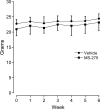Inhibition of histone deacetylases 1 and 3 protects injured retinal ganglion cells
- PMID: 23197683
- PMCID: PMC3544425
- DOI: 10.1167/iovs.12-10850
Inhibition of histone deacetylases 1 and 3 protects injured retinal ganglion cells
Abstract
Purpose: Thy-1 is a marker of retinal ganglion cell (RGC) differentiation. Optic nerve injury triggers reduction of Thy-1 promoter activation followed by retinal ganglion cell (RGC) death. This study determined whether MS-275, an inhibitor of the histone deacetylases 1 and 3, can inhibit these changes.
Methods: Mice expressing cyan fluorescent protein (CFP) under control of the Thy-1 promoter received MS-275 (subcutaneous) or vehicle three times per week starting 1 week before optic nerve crush and continuing for 6 weeks. The same retinal area was imaged using the blue-light confocal scanning laser ophthalmoscope before and after optic nerve crush every week, and fluorescent spots were counted manually. The eyes were then processed for histopathologic analysis.
Results: The mean proportions of fluorescent retinal neurons remaining in the vehicle group following optic nerve crush were 36 ± 8, 18 ± 6, 13 ± 10, 12 ± 4, 13 ± 5, and 13 ± 5% at weeks 1 through 6, respectively (n = 6). In contrast, the mean proportions of fluorescent retinal neurons remaining in the group treated with MS-275 were 59 ± 19, 39 ± 11, 34 ± 12, 33 ± 15, 32 ± 13, and 27 ± 15% at weeks 1 through 6, respectively (n = 7, P < 0.05 at weeks 1 through 5). Rate analysis showed that MS-275 slowed the rate of loss during the first 2 weeks by 23% (P < 0.05) and subsequently was similar. Histopathologic analysis revealed 27 ± 13% greater ganglion cell layer (GCL) neurons in the eyes from mice that received MS-275 treatment (P < 0.02).
Conclusions: These results indicate that treatment with MS-275 protects against the loss of RGC differentiation and promotes RGC survival following optic nerve injury.
Conflict of interest statement
Disclosure:
Figures






References
-
- Monti B, Polazzi E, Contestabile A. Biochemical, molecular and epigenetic mechanisms of valproic acid neuroprotection. Curr Mol Pharmacol. 2009; 2: 95–109 - PubMed
-
- Biermann J, Grieshaber P, Goebel U, et al. Valproic acid-mediated neuroprotection and regeneration in injured retinal ganglion cells. Invest Ophthalmol Vis Sci. 2010; 51: 526–534 - PubMed
-
- Lovell BV, Marmura MJ. Valproate semisodium ER for migraine and cluster headache prophylaxis. Expert Opin Drug Metab Toxicol. 2010; 6: 495–504 - PubMed
-
- Dolder CR, Nealy KL, McKinsey J. Valproic acid in dementia: does an optimal dose exist? J Pharm Pract. 2012; 25: 142–150 - PubMed
Publication types
MeSH terms
Substances
Grants and funding
LinkOut - more resources
Full Text Sources
Other Literature Sources
Medical
Molecular Biology Databases
Miscellaneous

